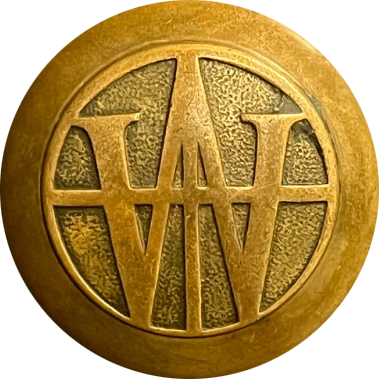Fun Facts

Our courthouse has been on the National Register of Historic Places since 1973 (read the 80-page nomination form) and has been a National Historic Landmark since 1996. It was named one of the country’s 200 key buildings by New York City’s Whitney Library of Design in 1993. If you work here long enough, you may run into a tourist from overseas, there to simply take pictures and admire the architecture.
The Roman brick used in our courthouse was from Sioux City Brick & Tile, manufactured in Sergeant Bluff, is made of Loess Hills soil, and was installed by local union workers.
William L. Steele is the architect of our courthouse, the largest public building built in the Prairie School style. The name comes from the long, horizontal framing and arrowhead motifs meant to pay homage to the long, flat horizons of the Midwestern prairies. Bringing in George Elmslie and William Purcell as associates, Steele designed a modern marvel of his time.
Woodbury County is named after Levi Woodbury—a governor, U.S. senator, Secretary of the Navy, Secretary of the Treasury, and associate justice of the United States Supreme Court—one of few people to serve in all three branches of U.S. government. It was almost the Wahkaw County Courthouse, but the legislature renamed the county after finding out what a great name Mr. Woodbury had.
Alfonso Iannelli, born in Italy, created the great eagle stretching westward from the eighth floor, and the sculpted figures above the west and north entrances. The west face depicts "The Spirit of the Law"--a Mosiac figure--surrounded by figures representative of society. The north face depicts the father, mother, and child—the family unit upon which civil society is built.
Iannelli created terra cotta friezes representing the 10 Commandments that were almost placed inside the west entrance. But controversy on how adultery was depicted nixed it, causing running bands of decorative ornament to be used instead.
Over 4,000 cream-colored terra cotta blocks adorn both the interior and exterior. Although they appear seamless at a distance, each piece was uniquely sculpted from freehand drawings. Think of them as 200-lb terra cotta snowflakes.
The rotunda’s east mural commemorates the Allied Powers of WWI. Given the fact that Japan and Italy switched teams during WWII, their flags were temporarily painted over for that time.
The Woodbury County Courthouse was one of only two courthouses in the country to have its own pharmacy. But it did not serve the general public, and supplies were kept in the former courthouse vault at night.
There are over 90 glass light globes in the rotunda and courtrooms. In 2016, the board of supervisors tasked their new building services director with finding a vendor who would replicate the damaged ones. A completely undamaged original was needed by the vendor. Quite literally, only a couple were in that state. We came very close to losing a piece of history.
Joseph Kobal, Sr. was the marble mason from Czechoslovakia who fashioned our stairs… and the face of Mount Rushmore, among other things. He attended trade school in Vienna with Adolph Hilter, who he said spent less time learning the trade and more time “jumping up on a box to convince the workmen to fight against capitalists.”
For decades, goldfish have had a tough time swimming in the pool on the rotunda’s south side. Either they stink up the area, or their water leaks out, or vandalism gets them. Fortunately, in early April 2018, life was reintroduced. Up until that date, nostalgic building services employees were known to occasionally pay their respects by placing plastic or printed fish in the empty pool.
A jail with prisoner and hospital cells is self-contained within five stories of our courthouse. Most cells are currently filled with dust and storage because there was a clear need to build the Law Enforcement Center across the street in 1988. A jail elevator in the courthouse still allows court personnel to bypass public areas by transporting prisoners directly to courtrooms.
The perforated disk at the top of the dome leads into a massive air duct used for ventilating back when smoking inside buildings was a thing. The counter near the rotunda's center used to be a cigar store. ‘Twas a different time!
The atrium’s murals and terra cotta pieces went over 70 years without a substantial cleaning. Accumulated dirt, tobacco smoke, coffee spilled from the mezzanine, and even grime from old coal-fired furnaces had darkened the murals and turned the white terra pieces an ugly yellow-brown. Around 1990, the Minneapolis-based Upper Midwest Conservation Association was called in for the clean-up job… and surprisingly… complimented the fact that the originals had never been sealed with a natural resin varnish. Why? Because modern synthetic resin was applied to last for decades, whereas older varnish that was available when the murals were installed in 1919 “would have turned amber brown within five years,” according to their senior paintings conservator.



 Stay Connected with Our County
Stay Connected with Our County